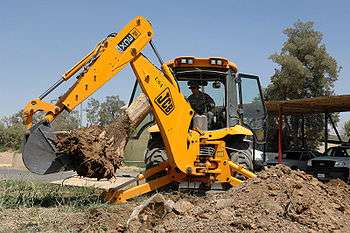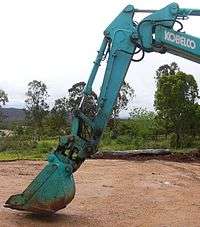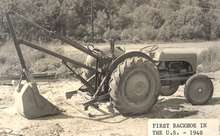Backhoe
A backhoe — also called rear actor or back actor — is a type of excavating equipment, or digger, consisting of a digging bucket on the end of a two-part articulated arm. It is typically mounted on the back of a tractor or front loader, the latter forming a "backhoe loader" (a US term, but known as a "JCB" in Ireland and the UK).[1] The section of the arm closest to the vehicle is known as the boom, while the section that carries the bucket is known as the dipper (or dipper-stick), both terms derived from steam shovels. The boom is generally attached to the vehicle through a pivot known as the king-post, which allows the arm to pivot left and right, usually through a total of 180 to 200 degrees.

Description

The term "backhoe" refers to the action of the bucket, not its location on the vehicle.[2] That is, a backhoe digs by drawing earth backwards, rather than lifting it with a forward motion like a person shovelling, a steam shovel, or a bulldozer. The buckets on some backhoes may be reconfigured facing forward, making them "hoes".
A tractor-loader backhoe (TLB) is a tractor-like vehicle with a backhoe at the rear, a front loader on the other and a swivelling seat to position the operator facing whichever direction is needed at the time. In North America, this arrangement is often referred to as simply a backhoe, or when on a chassis originally derived from farm tractors, a tractor loader backhoe (TLB). To differentiate, a backhoe on its own dedicated chassis may then be referred to as an excavator.
Backhoe loaders can be designed and manufactured from the start as such, or can be the result of a farm tractor equipped with a front end loader (FEL) and rear backhoe. Though similar looking, the purpose-designed backhoe loaders are much stronger, with the farm variation unsuitable for heavy work.
With the advent of hydraulic powered attachments such as a tiltrotator, breaker, a grapple or an auger, the backhoe is frequently used in many applications other than excavation and with the tiltrotator attachment, serves as an effective tool carrier. Many backhoes feature quick coupler (quick-attach) mounting systems for simplified attachment mounting, dramatically increasing the machine's utilization on the job site. Backhoes are usually employed together with loaders and bulldozers. Excavators that use a backhoe are sometimes called "trackhoes" by people who do not realize the name is due to the action of the bucket, not its location on a backhoe loader.
Backhoe loaders are general-purpose tools, and are being displaced to some extent by multiple specialist tools like the excavator and the speciality front end loader, especially with the rise of the mini-excavator. On many job sites which would have previously seen a backhoe used, a skidsteer and a mini excavator will be used in conjunction to fill the backhoe's role. However, backhoes still are in general use.
Sometimes a backhoe bucket is reversed to work in a power shovel configuration.[3]
Sometimes a backhoe arm is used as a crane, by slinging the lifted object from the support linkages behind the scoop (advisably not from the teeth, preferably from a hook welded on a bucket, quick coupler or tiltrotator).[4]
Origins

The backhoe swing frame was invented in 1947 by Vaino (pronounced Waino) J. Holopainen and Roy E. Handy Jr. The swing frame "allowed the hydraulic digging arm to swing to the side to dump the bucket under US patent # 2,698,697."[5] [6] In April 1948 Wain-Roy Corporation sold the very first hydraulic backhoe, mounted to a Ford Model 8N tractor, to the Connecticut Light and Power Company for $705.[5]
The first Tractor Loader Backhoe (TLB) was a Wain-Roy backhoe mounted to a Frank G. Hough model "HE" in 1952 in Holden, Massachusetts, US, for the Holden Water Department. The F.G. Hough Company was a subsidiary of the International Harvester Company. By early 1954, two Hough "Payloader" model wheel loaders, the HE and the HF, were available with Wain-Roy backhoes. In 1954 Wain-Roy Corporation got a deal with IH for the Hough TLB full-scale production on several other models of Hough loaders. [7]
In the same year, JCB launched the first European hydraulic loader, followed by a backhoe with a 180° slew, fitted to a tractor, in 1953. In 1957, CASE developed the first integrated tractor backhoe loader at the Case New Holland plant in Burlington, Vermont, helping contractors complete their work more efficiently.[8] JCB introduced the first dedicated backhoe loader, incorporating the excavator and the major loader in a single, all-purpose tool.[9]
In 1960 Vaino Holopainen was introduced as "Mr. Backhoe" to Henry Ford II. [7] Wain-Roy continued to produce them for Ford until 1963 when Ford made their own. Wain-Roy Corporation later bought the AC Anderson Company. [7] Although Wain-Roy Corporation no longer exists, the Wain Roy product line of backhoe attachments and couplers is still available through the Woods Equipment Company of Rockford, Illinois, US.
Because of the long-time predominance of the JCB marque in the United Kingdom and Ireland, it has become a genericized trademark there, and backhoe-equipped diggers are commonly called JCBs, while the term "backhoe" as an excavator component is almost unknown to the general public in this context. The founder of the JCB company, Joseph Cyril Bamford, is the only Briton to be honored in the Association of Equipment Manufacturers Hall of Fame.[9]
Backhoe fade
"Backhoe fade" or "JCB fade" is a term coined by the telecommunications industry to refer to accidental damage or complete severing of a communications cable by a backhoe or similar construction activity.[10][11]
The term is a play on other types of signal loss, especially on wireless networks. Most of these cause a reduction in the signal, such as rain fade. A cable subjected to "JCB fade" is instead a sudden and initially inexplicable loss of signal experienced when a cable is accidentally dug up and damaged or cut.
Notable manufacturers




















See also
References
- Glancey, Jonathan. "Classics of everyday design No 16". The Guardian. Guardian News and Media Limited. Retrieved 19 August 2017.
- "Tractor Back Hoe & Loader Mechanism". Retrieved 2019-04-23.
- "Power Shovels" (PDF). 2018-01-19. Retrieved 2019-05-03.
- "Strategic Forum for Construction". 2014-09-14. Archived from the original on 2014-09-14. Retrieved 2018-03-27.
- "These are the forgotten inventors of the backhoe, new book claims". Equipment World. Retrieved 2019-05-17.
- Wain-Roy and the invention of the backhoe as told in 1991, retrieved 2020-02-05
- Horton, Lee (2018). "Wain-Roy and the Invention of the Backhoe". www.digrock.com. Retrieved 2020-02-05.
- "Integrated tractor backhoe has roots in southeast Iowa". The Washington Times. Retrieved 2019-05-25.
- Phillips, David (2001-03-05). "Obituary: Joseph Bamford | News". London: The Guardian. Retrieved 2009-09-15.
- "backhoe fade – technical definition". YourDictionary. yourdictionary.com. 2010. Retrieved 2012-08-12.
Original source: Webster's New World Telecom Dictionary, 2010 by Wiley Publishing, Inc.
- Urimindi, Reddy (2005). "Network Protection and Redundancy". (refer to 'backhoe fade'). Neptec Optical Solutions. Archived from the original on September 30, 2007. Retrieved 2007-03-08.
External links
| Wikimedia Commons has media related to Backhoe loaders. |
- HowStuffWorks page on backhoe loaders, including animations and a simulator
- How Products Are Made: Backhoe – from enotes.com
- NIOSH Publication: Preventing Injuries When Working With Hydraulic Excavators and Backhoe Loaders